Liang Cao
VoxRole: A Comprehensive Benchmark for Evaluating Speech-Based Role-Playing Agents
Sep 04, 2025Abstract:Recent significant advancements in Large Language Models (LLMs) have greatly propelled the development of Role-Playing Conversational Agents (RPCAs). These systems aim to create immersive user experiences through consistent persona adoption. However, current RPCA research faces dual limitations. First, existing work predominantly focuses on the textual modality, entirely overlooking critical paralinguistic features including intonation, prosody, and rhythm in speech, which are essential for conveying character emotions and shaping vivid identities. Second, the speech-based role-playing domain suffers from a long-standing lack of standardized evaluation benchmarks. Most current spoken dialogue datasets target only fundamental capability assessments, featuring thinly sketched or ill-defined character profiles. Consequently, they fail to effectively quantify model performance on core competencies like long-term persona consistency. To address this critical gap, we introduce VoxRole, the first comprehensive benchmark specifically designed for the evaluation of speech-based RPCAs. The benchmark comprises 13335 multi-turn dialogues, totaling 65.6 hours of speech from 1228 unique characters across 261 movies. To construct this resource, we propose a novel two-stage automated pipeline that first aligns movie audio with scripts and subsequently employs an LLM to systematically build multi-dimensional profiles for each character. Leveraging VoxRole, we conduct a multi-dimensional evaluation of contemporary spoken dialogue models, revealing crucial insights into their respective strengths and limitations in maintaining persona consistency.
Anomaly Detection and Generation with Diffusion Models: A Survey
Jun 11, 2025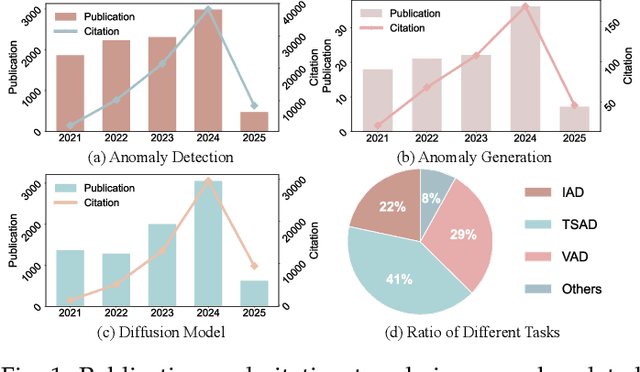

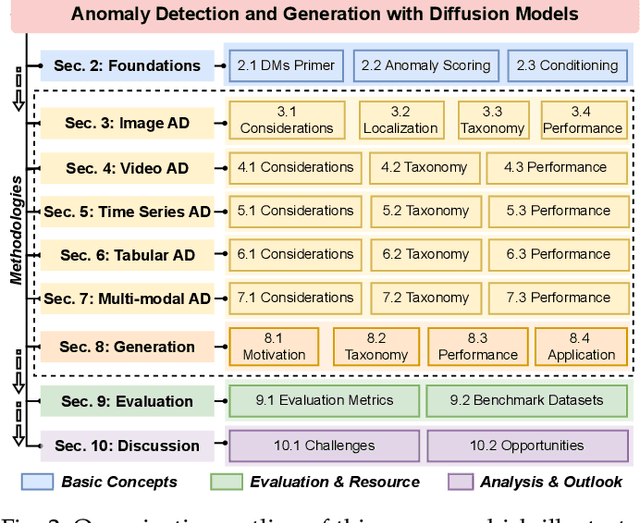

Abstract:Anomaly detection (AD) plays a pivotal role across diverse domains, including cybersecurity, finance, healthcare, and industrial manufacturing, by identifying unexpected patterns that deviate from established norms in real-world data. Recent advancements in deep learning, specifically diffusion models (DMs), have sparked significant interest due to their ability to learn complex data distributions and generate high-fidelity samples, offering a robust framework for unsupervised AD. In this survey, we comprehensively review anomaly detection and generation with diffusion models (ADGDM), presenting a tutorial-style analysis of the theoretical foundations and practical implementations and spanning images, videos, time series, tabular, and multimodal data. Crucially, unlike existing surveys that often treat anomaly detection and generation as separate problems, we highlight their inherent synergistic relationship. We reveal how DMs enable a reinforcing cycle where generation techniques directly address the fundamental challenge of anomaly data scarcity, while detection methods provide critical feedback to improve generation fidelity and relevance, advancing both capabilities beyond their individual potential. A detailed taxonomy categorizes ADGDM methods based on anomaly scoring mechanisms, conditioning strategies, and architectural designs, analyzing their strengths and limitations. We final discuss key challenges including scalability and computational efficiency, and outline promising future directions such as efficient architectures, conditioning strategies, and integration with foundation models (e.g., visual-language models and large language models). By synthesizing recent advances and outlining open research questions, this survey aims to guide researchers and practitioners in leveraging DMs for innovative AD solutions across diverse applications.
Augmentation-based Unsupervised Cross-Domain Functional MRI Adaptation for Major Depressive Disorder Identification
May 31, 2024



Abstract:Major depressive disorder (MDD) is a common mental disorder that typically affects a person's mood, cognition, behavior, and physical health. Resting-state functional magnetic resonance imaging (rs-fMRI) data are widely used for computer-aided diagnosis of MDD. While multi-site fMRI data can provide more data for training reliable diagnostic models, significant cross-site data heterogeneity would result in poor model generalizability. Many domain adaptation methods are designed to reduce the distributional differences between sites to some extent, but usually ignore overfitting problem of the model on the source domain. Intuitively, target data augmentation can alleviate the overfitting problem by forcing the model to learn more generalized features and reduce the dependence on source domain data. In this work, we propose a new augmentation-based unsupervised cross-domain fMRI adaptation (AUFA) framework for automatic diagnosis of MDD. The AUFA consists of 1) a graph representation learning module for extracting rs-fMRI features with spatial attention, 2) a domain adaptation module for feature alignment between source and target data, 3) an augmentation-based self-optimization module for alleviating model overfitting on the source domain, and 4) a classification module. Experimental results on 1,089 subjects suggest that AUFA outperforms several state-of-the-art methods in MDD identification. Our approach not only reduces data heterogeneity between different sites, but also localizes disease-related functional connectivity abnormalities and provides interpretability for the model.
A Versatile Framework for Analyzing Galaxy Image Data by Implanting Human-in-the-loop on a Large Vision Model
May 17, 2024Abstract:The exponential growth of astronomical datasets provides an unprecedented opportunity for humans to gain insight into the Universe. However, effectively analyzing this vast amount of data poses a significant challenge. Astronomers are turning to deep learning techniques to address this, but the methods are limited by their specific training sets, leading to considerable duplicate workloads too. Hence, as an example to present how to overcome the issue, we built a framework for general analysis of galaxy images, based on a large vision model (LVM) plus downstream tasks (DST), including galaxy morphological classification, image restoration, object detection, parameter extraction, and more. Considering the low signal-to-noise ratio of galaxy images and the imbalanced distribution of galaxy categories, we have incorporated a Human-in-the-loop (HITL) module into our large vision model, which leverages human knowledge to enhance the reliability and interpretability of processing galaxy images interactively. The proposed framework exhibits notable few-shot learning capabilities and versatile adaptability to all the abovementioned tasks on galaxy images in the DESI legacy imaging surveys. Expressly, for object detection, trained by 1000 data points, our DST upon the LVM achieves an accuracy of 96.7%, while ResNet50 plus Mask R-CNN gives an accuracy of 93.1%; for morphology classification, to obtain AUC ~0.9, LVM plus DST and HITL only requests 1/50 training sets compared to ResNet18. Expectedly, multimodal data can be integrated similarly, which opens up possibilities for conducting joint analyses with datasets spanning diverse domains in the era of multi-message astronomy.
A GPU-Accelerated Moving-Horizon Algorithm for Training Deep Classification Trees on Large Datasets
Nov 12, 2023



Abstract:Decision trees are essential yet NP-complete to train, prompting the widespread use of heuristic methods such as CART, which suffers from sub-optimal performance due to its greedy nature. Recently, breakthroughs in finding optimal decision trees have emerged; however, these methods still face significant computational costs and struggle with continuous features in large-scale datasets and deep trees. To address these limitations, we introduce a moving-horizon differential evolution algorithm for classification trees with continuous features (MH-DEOCT). Our approach consists of a discrete tree decoding method that eliminates duplicated searches between adjacent samples, a GPU-accelerated implementation that significantly reduces running time, and a moving-horizon strategy that iteratively trains shallow subtrees at each node to balance the vision and optimizer capability. Comprehensive studies on 68 UCI datasets demonstrate that our approach outperforms the heuristic method CART on training and testing accuracy by an average of 3.44% and 1.71%, respectively. Moreover, these numerical studies empirically demonstrate that MH-DEOCT achieves near-optimal performance (only 0.38% and 0.06% worse than the global optimal method on training and testing, respectively), while it offers remarkable scalability for deep trees (e.g., depth=8) and large-scale datasets (e.g., ten million samples).
AIM 2020 Challenge on Real Image Super-Resolution: Methods and Results
Sep 25, 2020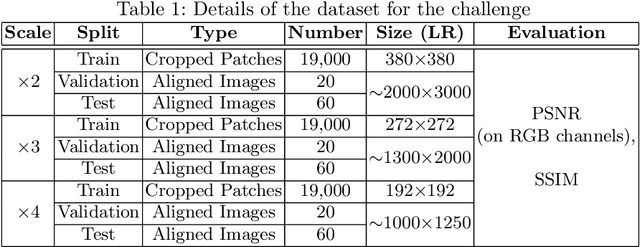
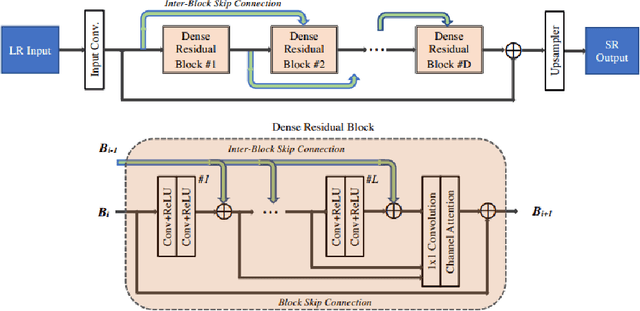
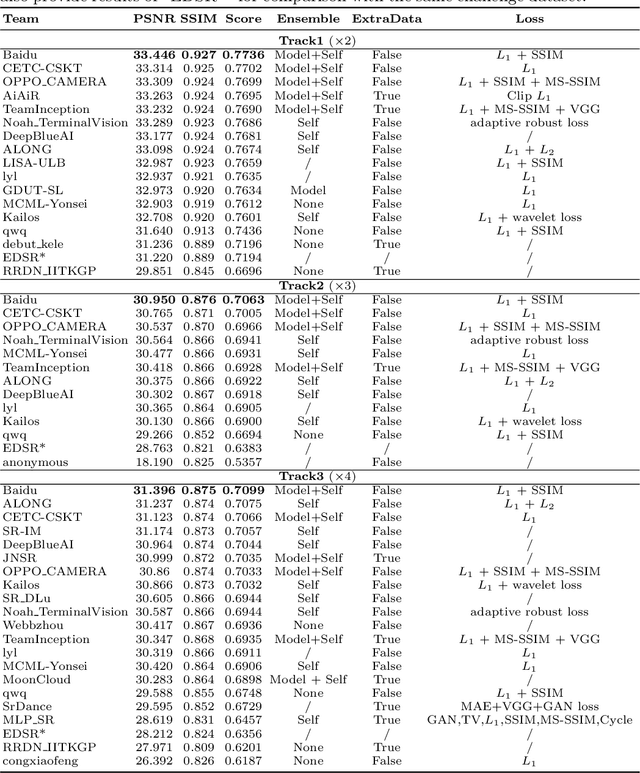
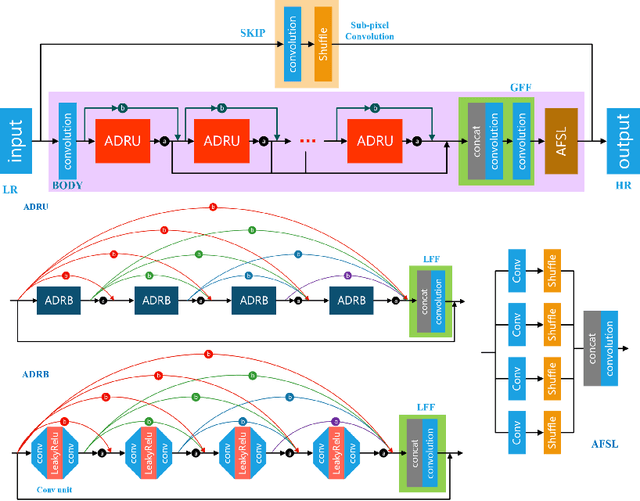
Abstract:This paper introduces the real image Super-Resolution (SR) challenge that was part of the Advances in Image Manipulation (AIM) workshop, held in conjunction with ECCV 2020. This challenge involves three tracks to super-resolve an input image for $\times$2, $\times$3 and $\times$4 scaling factors, respectively. The goal is to attract more attention to realistic image degradation for the SR task, which is much more complicated and challenging, and contributes to real-world image super-resolution applications. 452 participants were registered for three tracks in total, and 24 teams submitted their results. They gauge the state-of-the-art approaches for real image SR in terms of PSNR and SSIM.
 Add to Chrome
Add to Chrome Add to Firefox
Add to Firefox Add to Edge
Add to Edge